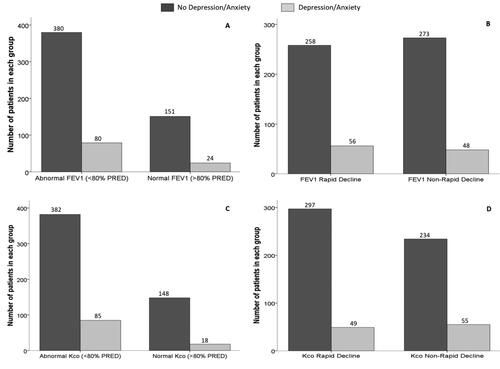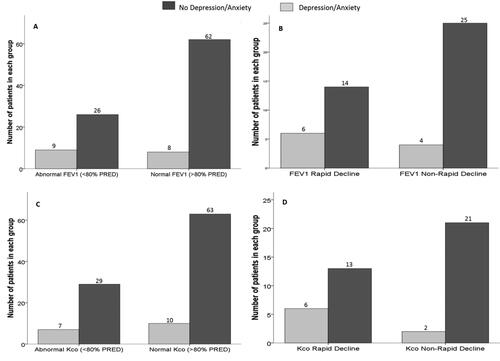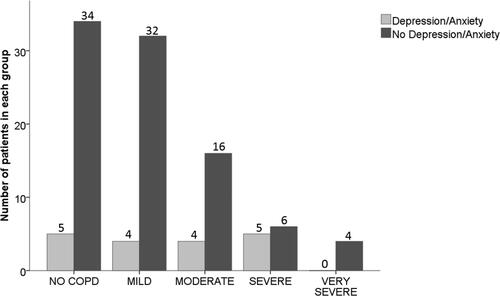Figures & data
Table 1. Data is shown for the PiZZ/PiZnull AATD cohort at baseline and subsequent annual decline in spirometry and HS for those with and without a clinical diagnosis of depression and anxiety.
Table 2. Data is shown for the PiSZ AATD cohort at baseline and subsequent annual decline in spirometry and HS for those with and without a clinical diagnosis of depression and anxiety.
Figure 1. The distribution of mMRC scores in the PiZZ/PiZnull cohort in those with and without depression and/or anxiety.
Notes: The bar chart demonstrates the proportion of mMRC scores in both groups with a higher percentage of mMRC score of 1 in those with no depression or anxiety and a higher percentage of mMRC score of 3 in those with depression and/or anxiety.
Abbreviations: mMRC score, modified Medical Research Council score.

Figure 2. The distribution of mMRC scores in the PiSZ cohort in those with and without depression and/or anxiety.
Notes: The bar chart shows the proportion of mMRC scores in both groups with a higher percentage of mMRC score of 0 in those with no depression or anxiety and a higher percentage of mMRC score of 1 in those with depression and/or anxiety.
Abbreviations: mMRC score, modified Medical Research Council score.

Figure 3. Lung function and rate of decline in AATD subjects (PiZZ/PiZnull cohort) in those with or without depression and/or anxiety.
Notes: demonstrates the number of subjects (in those with or without depression and/or anxiety) displaying normal or abnormal FEV1. demonstrates the number of subjects (in those with or without depression and/or anxiety) displaying rapid or non-rapid decline in FEV1. demonstrates the number of subjects (in those with or without depression and/or anxiety) displaying normal or abnormal Kco. demonstrates the number of subjects (in those with or without depression/anxiety) displaying rapid or non-rapid decline in Kco.
Abbreviations: FEV1, Forced Expiratory Volume in 1 Second; Kco, Transfer Coefficient for carbon monoxide; PRED, Predicted.

Figure 4. Lung function and rate of decline in AATD subjects (PiSZ cohort) in those with or without depression and/or anxiety.
Notes: demonstrates the number of subjects (in those with or without depression and/or anxiety) displaying normal or abnormal FEV1. demonstrates the number of subjects (in those with or without depression and/or anxiety) displaying rapid or non-rapid decline in FEV1. demonstrates the number of subjects (in those with or without depression and/or anxiety) displaying normal or abnormal Kco. demonstrates the number of subjects (in those with or without depression and/or anxiety) displaying rapid or non-rapid decline in Kco.
Abbreviations: FEV1, Forced Expiratory Volume in 1 Second; Kco, Transfer Coefficient for carbon monoxide; PRED, Predicted.

Figure 5. Different severity stages of COPD and no COPD in those with or without depression and/or anxiety PiZZ/PiZnull cohort.
Notes: The bar chart demonstrates the number of those with or without COPD and those with different severity stages of COPD as defined by GOLD in those with or without depression and/or anxiety.
Abbreviations: COPD, Chronic Obstructive Pulmonary Disease; GOLD, Global initiative for Chronic Obstructive Lung Disease.

Figure 6. Different severity stages of COPD in those with or without depression and/or anxiety PiZZ/PiZnull cohort.
Notes: The bar chart demonstrates the number of those with or without COPD and those with different severity stages of COPD as defined by GOLD in those with or without depression and/or anxiety.
Abbreviations: COPD, Chronic Obstructive Pulmonary Disease; GOLD, Global initiative for Chronic Obstructive Lung Disease.

Data availability statement
Data from this study will not be publicly available due to the terms of the patient consent to participation.
